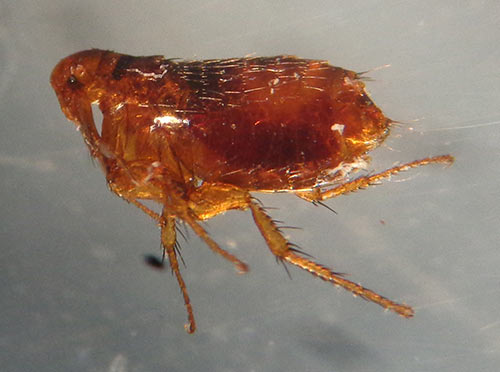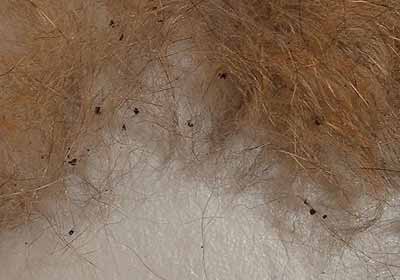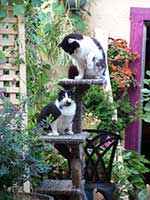
How do I know if my cat or dog has fleas?
There are many signs that an animal has fleas. Here are a few. This is how to check your cat or dog for fleas.

You can see Fleas on your cat or dog
Put your glasses on, grab a cat (gently) and go to a well lit spot. It helps if someone is there to distract the cat while you look for fleas.
There are several spots that are good to check for fleas. Any area such as around the tail, where your cat or dog can't scratch should be checked. In particular the lower back and base of the tail. You have to move fast because the flea moves very quickly in the hair. If you don't know what a flea looks like check out the "what do fleas look like page". You might only see something moving through the cat fur very quickly. Another good spot is between the legs and in the animal's armpits or where his armpits would be if he had them. The whole belly area should be checked. Fleas can be reddish brown to black.
If your cat doesn't mind taking a bath, then give puss a bath and check the head because fleas will usually find their way to the top of the head where things are drier. None of my cats like baths so that's not a good option.
Dogs are usually easier to bathe.
Fleas Will Bite Humans
Although humans are not a good host for fleas and it's almost impossible for them to get enough nourishment from humans to lay eggs, they will bite us. If you start having unexplained little red bite marks then suspect fleas. The bite marks may or may not itch.
Being bitten by a flea is not a big deal but fleas can carry disease and pass it on to you. This is particularly important if your cat goes outside and could be bringing in wild animal fleas, raccoons, rats and other critters can carry diseases and pass them on to you by way of infected fleas. In the Middle Ages, bubonic plague was transmitted by fleas from infected rats.
Flea combs and Flea Traps
Using a flea comb can also sometimes catch fleas, you have to move quickly and run the comb through the fur. When you catch fleas put them in a bowl of hot soapy water and keep combing. You will not be able to catch all the fleas and it is laborious. Flea combs are not a great way of ridding a cat of fleas but it's useful if you are checking for fleas. I mostly use mine to pull out the shedding undercoat in the spring. It works really well for that but you have to brush your cat first to align the hair otherwise it pulls too much.
You can buy "flea traps". These are small lights that attract fleas and when they jump around it they get stuck in the sticky trap set below the light. There are several commercial ones such as the Victor, but you can also make one by setting a lamp with an incandescent light bulb (not a LED, it needs to get warm) and setting a bowl of soapy water under the lamp. Fleas will jump to the warm light and land in the soapy water and drown. Setting a trap will help you see if you have fleas but will not control them very well because it only targets adult fleas. It's useful to figure out where the fleas are hanging out though. Victor makes a trap: Victor M230 Ultimate Flea Trap (Pack of 2, Multy)
We were away and now there are lots of fleas, why?
Sometimes if the animals have been away for a while and comes back to the home after holidays for example, then you might see fleas jumping on you or the cat after a day or so. Fleas emerge from their cocoon very quickly when they feel there is food around. The pupa waits till it can sense heat, vibrations, or carbon dioxide from an animal, and if you were away it might have waited.
Fleas can stay dormant for several months particularly if it's cold.
This happens quite often, and sometimes if your dog or cat was in a boarded in a kennel, they gets unjustly blamed for giving your cat fleas, while the real reason your cat shows fleas after coming home is that the pupa hatched when it sensed your cat. Clever little fleas but annoying for people.
What other signs are there that my cat or dog has fleas?
Checking for flea dirt is a good way of confirming a flea infestation

Flea Dirt is the dropping of mature fleas. This flea poo looks like little black grains.
When a flea feeds the droppings are left on the cat or dog and this flea dirt then falls on the bedding or anywhere else the animal sleeps, including your bed.
it's very easy to check for flea dirt on a cat or dog. Put your friend on a newspaper or white sheet, or in the dry bathtub, and ruffle his fur backwards and forwards. This will make any flea dirt fall on the piece of paper.
To check if the black spots are flea dirt rather than just old fashioned dirt, because puss was rolling around in the garden, take a wet paper towel and wipe up the specs that fell. If it's flea dirt then wetting it will make the spots red or brownish red, because of the high blood content. If the spots stay black then they are not flea dirt.
You can wipe the animal's bed with a damp paper towel and check it for dark red bloody spots. The spots will not be bright red, rather sort of rusty brown.
Many cats and dogs have flea allergies
If your cat or dog has lots of little sores and scabs in front of his tail then it is very possible he is allergic to fleas.

Feline Milliary Dermatitis is sometimes caused by cat allergies to flea saliva. One single bite can trigger the reaction.
It's possible for your cat to have a very low level of flea infestation where you cannot see any adult and there are not enough fleas to make flea dirt for you to find. If the cat receives only a small number of bites it can still react and get a rash or sores.
In that case you might want to check with your vet to confirm that there are fleas, even in tiny numbers. I have a page on cat allergies.
It's not unusual for dogs and cats to lose hair and sometimes smell bad if they have a heavy flea infestation.
Another sign to watch for is scratching or excessive grooming
An animal that has fleas is not comfortable and will scratch and bite his fur energetically. If you see your cat or dog doing this then suspect fleas even if you don't find any other signs. Itchy skin can be a sign of allergy but suddenly biting a spot energetically is usually a hunt for a flea. An energetic healthy cat can reduce his flea load by 50% by active grooming. Kittens and older cats are not so successful. Dog are also not as good as cats in grooming out fleas. Not only do they not groom as much but they can't reach as well as a cat.
Some dogs or cats will groom to excess if they have fleas. This and scratching can cause sores or hair loss.
Heavy flea infestations sometimes are accompanied by infections. Fungal or bacterial infections will need to be treated by a vet, along with treating the animal for fleas. Suspect an infection if the area smell particularly bad, has a lot of crusty scabs or oozing sores.
Anemia is a possible result of flea infestation
If you keep an eye on your cat or dog it is unlikely that it will have so many fleas that it becomes anemic from blood loss. Kittens are more likely to suffer from anemia than mature cats. So check your cat regularly. A lethargic listless animal with pale nose and gums could be anemic.

So what's the next step?
Because the so called 'cat flea' is not very choosy as to what mammal it feeds on, it does not just stay on a cat but so you have to treat all the dogs and cats, rabbits and whatever other animal lives with the cat. If you only treat the cat it will catch fleas from the other animals and you job will have to start all over again.
If your cat is flea free, doesn't go outside and you can find no sign of flea infestation, and no scratching then you are lucky, and so is your friend. Keep an eye on him, keep the bedding vacuumed and check regularly. No need to treat, why treat a clean animal?
If you suspect an infestation because your dog or cat is scratching or has sores, but you can't find anything, then check with your vet to see what he or she suggests. It is not necessarily fleas, cats can get allergies just like people. If the number of fleas is small you might not be able to find any sign.
The same goes for a listless pale animal. The gums will be very pale if she's anemic. Suspect fleas but check with your vet before treating a potentially sick animal.
Don't randomly treat your cat. There are several products available from the vet that are much safer than what you can buy at the pet store. NEVER USE DOG FLEA PRODUCTS ON A CAT OR NEAR A CAT. Cat are not capable of getting rid of poisons very well and you could kill your cat. Some dog flea medicine is so poisonous to your cat that just hanging out with the dog and licking him is enough to poison the cat.
If you have found signs of fleas on your pet then you need to take steps to control the fleas. One of the most successful ways of treating for fleas is monthly drops between the shoulder blades. There are many brands, Frontline, Revolution, Advantage, are examples.
If the infection is large, an insect growth regulator IGR will help and is relatively non toxic. An isect growth regulator acts by preventing growing fleas from maturing. This way they cannot become adult fleas and so cannot reproduce and bite your animal. Insect Growth Regulators do not kill adult fleas but prevents them from reproducing.4 oz Martin's I.G. Regulator (IGR) Insect Growth Regulator Concentrate 1.3% Nylar ~ Effective Long-Term Control Of Fleas, Roaches, Flies, Mosquitoes, Gnats, Crickets, Litter Beetles & Ants ~~ Indoor & Outdoor Use Treats 6,000 SQ FT
If your dog or cat goes outside or you have dogs that go out and cats that don't then it is unlikely you will get rid of fleas completely. You can do a good job of controlling them though.
Read my Flea Control PageThe pictures of the flea dirt and dermatitis come from Wikipedia the others are my own.
This web site reflects my personal ideas and doesn't represent anyone else's point of view.
Amazon requires that the following disclosure be included in my website. "I am a participant in the Amazon Services LLC Associates Program, an affiliate advertising program designed to provide a means for us to earn fees by linking to Amazon.com and affiliated sites.”
I have the links to help pay for the website.
emails: ChristineThis article is provided for information only. It is not to be used instead of consulting a VET. If your kitty is sick get some help.
Flea Links
The U.of Kentucky has an article on flea control with links to products.What do cat fleas, eggs and larva look like
How to kill and control fleas on cat There are effective ways of killing fleas and getting rid of the eggs and larvae
More Natural flea control for cat fleas
Life cycle of the cat flea is complex. Understanding this life cycle makes it easier to kill and control cat fleas
Cats of Australia How to tell if your pet has fleas.
Cat World Australia flea page
Cornell University, flea article
Wikipedia's entry fleas
Veterinary Partner has a link to flea treatment products. link is pdf file
University of California has a good article on flea control including photos to show what a flea egg looks like and photo of flea larva.
Between the shoulder blade drops are very effective but expensive. The ones sold by vets are very safe, some sold by pet stores are not. Beware when buying from the Internet, because there are a lot of counterfeit medicine. Read the comments and if the price is too good then it's probably fake. I carefully check my links but I'm not the seller of these products.
Never use a DOG product on a cat.
Martin's insect growth regulator, concentrated. To treat premises. Growth regulators interfere with the flea life cycle and prevent them from maturing. Because they interfere with the insect development only they are considered quite safe.
Victor Flea Trap Package of 2 sticky refills
Pet Republique Dog & Cat Flea Comb - for Most Dogs, Cats, Rabbits, Pets – Best Grooming tool to Remove Fleas, Mites, Ticks, & Dandruff Flakes – Safe & Fine Pins

Cat Links
Cat Navigation PageBooks about cats For reference and amusement
Cat Ear Mites are a common problem See what a ear mite looks like.
Allergies in Cats
Hairballs in Cats
Cat Gardens
Plants Cats Like
My Cats
Cats at Work
How to get rid of cat urine smell
Feline Leukemia
Grow some catnip or grass for your cat
In Canada
Some Books about Cat Health and Veterinary References
Cat Owner's Home Veterinary Handbook

ASPCA Complete Guide to Cats:

Merck merial Manual for Pet Health


Scotch-Brite Lint Roller Combo Pack, 5-Rollers, 95-Sheets/Roller (475 Sheets Total)
Veterinary Technician's Daily Reference Guide

Cat Behaviour can be Puzzling, here are some books that might help
Cat Behaviourist helps you understand the complex field of cat behaviour. She has a good reputation.
Think Like a Cat: How to Raise a Well-Adjusted Cat--Not a Sour Puss
